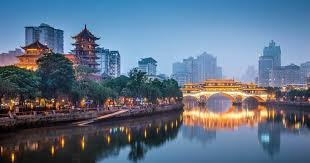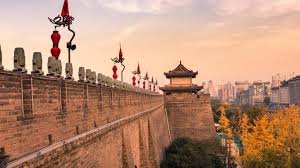China, a country with over 5,000 years of history, boasts some of the world’s most vibrant and dynamic cities. Each city in China offers a unique blend of ancient tradition and modern innovation, making it a fascinating destination for travelers, businesspeople, and history enthusiasts alike. In this blog, we’ll take a closer look at some of the top cities in China, each with its own distinct character and charm.

1. Beijing: The Heart of China
As the capital city, Beijing is a political, cultural, and historical hub. It is home to iconic landmarks like the Great Wall, the Forbidden City, and Tiananmen Square. These sites are symbols of China’s imperial past and offer a glimpse into the country’s long and complex history.
Beijing is also a city of contrasts, where ancient temples coexist with futuristic skyscrapers. The city has seen rapid modernization over the past few decades, with state-of-the-art infrastructure, including a vast subway system and the futuristic Beijing Daxing International Airport. Despite its modernization, Beijing has preserved its traditional hutongs (narrow alleys), where one can still find traditional courtyards and local markets.

2. Shanghai: The Financial Powerhouse
Shanghai, often dubbed the “Paris of the East,” is China’s largest city and its most important financial center. The city is renowned for its stunning skyline, especially the Bund, where colonial-era buildings meet the modern skyscrapers of Pudong, including the Shanghai Tower and the Oriental Pearl TV Tower.
Shanghai is a city that never sleeps, with a bustling nightlife, luxury shopping districts, and a thriving food scene. It’s also a city of firsts: the first-ever Chinese Communist Party meeting was held here, and it was the first city in China to have a metro system. Today, Shanghai is a symbol of China’s economic rise and global influence.

3. Guangzhou: The Trading Giant
Located in the southern part of China, Guangzhou is known as the “City of Rams” and is a vital port city. Historically, it was the starting point of the Maritime Silk Road, making it a key player in China’s trade with the world. Today, Guangzhou remains an economic powerhouse, hosting the Canton Fair, the largest and oldest trade fair in China.
Guangzhou is also famous for its culinary scene, particularly Cantonese cuisine, which is known for its subtle flavors and fresh ingredients. Visitors can explore the city’s vibrant street food scene or dine in world-class restaurants offering delicacies like dim sum, roasted meats, and seafood.

4. Shenzhen: The Tech Hub
Shenzhen, once a small fishing village, has transformed into a global technology and innovation hub in just a few decades. Located near Hong Kong, Shenzhen was designated as China’s first Special Economic Zone in 1980, leading to rapid economic growth and urbanization.
Today, Shenzhen is home to some of the world’s largest tech companies, including Huawei and Tencent. The city is a magnet for entrepreneurs and tech enthusiasts, offering a glimpse into the future with its smart city initiatives, 5G infrastructure, and cutting-edge technology parks like Shenzhen Hi-Tech Industrial Park.

Shenzhen is also known for its modern architecture, such as the Ping An Finance Centre and the Shenzhen Opera House, as well as its shopping districts and cultural attractions like OCT Loft and Window of the World.
5. Chengdu: The Cultural Capital of the West
Chengdu, the capital of Sichuan province, is known for its laid-back lifestyle and rich cultural heritage. It is the gateway to China’s western regions and is famous for being the home of the giant panda. Visitors can visit the Chengdu Research Base of Giant Panda Breeding to see these adorable animals up close.

Chengdu is also the birthplace of Sichuan cuisine, which is renowned for its bold, spicy flavors. The city’s teahouses, hot pot restaurants, and street food stalls offer a culinary experience like no other.
In addition to its culinary delights, Chengdu has a rich cultural scene, with traditional Sichuan opera performances, ancient temples like Wuhou Shrine, and historical sites such as the Jinsha Site Museum.
6. Xi’an: The Ancient Capital
Xi’an, the capital of Shaanxi province, is one of China’s oldest cities and served as the capital for several of China’s ancient dynasties. It is most famous for the Terracotta Army, a massive collection of life-sized sculptures depicting the armies of the first Emperor of China, Qin Shi Huang.

As the starting point of the Silk Road, Xi’an was a melting pot of cultures, religions, and ideas. Today, visitors can explore the city’s ancient city walls, the Big Wild Goose Pagoda, and the bustling Muslim Quarter, which is known for its vibrant markets and delicious street food.
7. Hangzhou: The Scenic Beauty
Hangzhou, the capital of Zhejiang province, is often referred to as “Heaven on Earth” due to its stunning natural beauty. The city is famous for West Lake, a UNESCO World Heritage site, which has inspired poets and artists for centuries. The lake’s tranquil waters, surrounded by temples, pagodas, and gardens, make it a popular destination for both locals and tourists.

In addition to its natural beauty, Hangzhou is a hub for the tech industry and e-commerce, being the headquarters of Alibaba, one of the world’s largest companies. The city seamlessly blends its historical charm with modern innovation, making it a fascinating place to visit.
Conclusion
China’s top cities each offer a unique perspective on the country’s rich history, cultural diversity, and rapid modernization. Whether you’re exploring the ancient wonders of Xi’an, the bustling streets of Shanghai, or the technological marvels of Shenzhen, China’s cities provide a captivating journey through the past, present, and future of this extraordinary nation.

No Responses